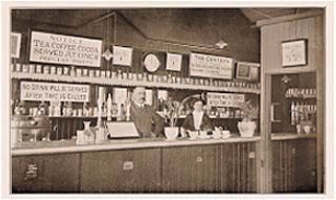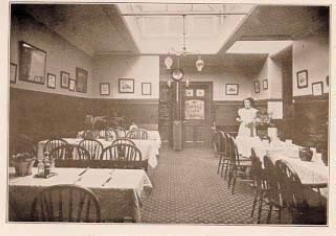
Copyright © 2005 the Brewery History Society
|
Journal Home > Archive > Issue Contents > Brew. Hist., 120, pp. 35-42 |
Some Guidelines for Writing Historical Articles |
by David W Gutzke |
As a long-time reader of this journal, I have been struck by the fact that much of the research published here could have broader appeal to other members of the Society as well as academics if certain guidelines were followed in researching and writing the articles. This is especially critical because the surviving records of the brewing industry represent only a fraction of what once existed. Many large and medium sized breweries - Julia Hanson & Sons, Hewitt Brothers, Hull Brewing Co., James Deuchar, John J. Hunt, Leeds & Wakefield Breweries, Leicester Brewing & Malting Co., the Lion Brewery Co. among others - have virtually no archival material at all. Researchers working at the local level with newspapers, census material and other primary sources could help fill these gaps, making a contribution that would transcend the purpose of the initial article. When I was trying to trace the pubs that breweries built or rebuilt in interwar England for my book on the improved public house movement, some studies did provide information that I could find nowhere else. But unfortunately numerous other authors might have known the information, but did not grasp its importance. It is precisely this lack of awareness of a wider reader audience that I want to address in this article.
Some years ago now in these pages I followed an animated debate among members on whether citations were in fact necessary. As I recall, the preponderance of replies was in the negative. One of the basic rules about academic research is that another scholar must be able to replicate, at least in theory, from the references the findings that support a conclusion. In some cases, this may prove virtually impossible, except in a general sense. I ultimately identified thousands of pubs that brewers built or rebuilt, preventing any detailed list of sources for each of the premises. But even here, should someone request information, I can cite specific records containing the data. Quotations, statistics not commonly available, and obituaries deserve documentation. Sources for information drawn from books, articles, pamphlets, newspapers, corporate records, legal and government documents, census returns, reference guides (such as Who was Who or the Dictionary of National Biography), and privately printed or unpublished material likewise must be identified clearly in citations. The reference itself should be specific (author and title) and where possible include pagination. Here is one example: F. Goldsbrough, 'The Modern Public House,' Journal of the Incorporated Brewers' Guild 21 (1935): 195-202. When using archival material, the reference number and date of the record ought to be included: Barclay, Perkins, & Co., Estate Report Book, Courage Archives, AI/E/15, 25 July 1932, p. 7. Because many records of the biggest breweries have been recently dispersed to several repositories, it is especially critical to identify where the records are located to assist the reader. Records of the Courage Brewery, Dartford Brewery, Nicholson & Sons, Royal Brewery (Brentford), and Watney, Combe & Reid, for example, are held by both the Courage Archives (Bristol) and the London Metropolitan Library.
Some kinds of information need no references: names, dates, locations, the weather, and commonly known events (such as the King's coronation). As a rule of thumb, where the general reader would be unable to locate some material the researcher should provide documentation.
Researchers should not, as my colleague says, reinvent the wheel. Before beginning research, a check should be made of existing research to avoid needless duplication. I can recall reading an article in this journal that was perfectly splendid, save for the fact that I had already published an article on the subject covering the same ground a decade earlier. With so many other topics awaiting research, this is not, as one of my friends would have observed, the best way of spending one's time. There are ways to determine quickly if the topic has drawn previous scholarship. In 1996 I published a guide to the literature, Alcohol in the British Isles from Roman Times to 1996: An Annotated Bibliography, containing some 2200 references (including numerous articles from the JBHS) with separate chapters devoted to the brewing industry, beverages, licensed premises, biographies, autobiographies and memoirs. 1 To facilitate its use, I compiled detailed author and index subject indexes spanning 22 pages. For the intervening years, the researcher should consult bibliographies published in each issue of The Social History of Alcohol Review (now Alcohol and Drugs History), together with this journal.
|
|
 |
|
|
When engaged in investigating a topic, the researcher ought to have framed specific questions on which to gather information. Otherwise, everything seemingly has equal importance, and the writing of any history is in danger of becoming a collection of unrelated facts, or, as one famous British historian remarked, a record of 'one damn thing after another.' Being mindful of key subjects for research can unearth material of enormous use to others interested in related topics. Below is a list of possible research topics that could be approached at the local level:
Remember to resist the temptation to record excessive detail about a subject. It is entirely unnecessary, for instance, to list the names of all directors, managers or licensees. In an appendix, it might be useful to identify when a brewery acquired pubs, but not without some further information, such as the cost, date and former owner. The historian's role is to analyze causation, impact and significance. Where possible, comparisons and contrasts should be drawn with other breweries or regions, and then explanations provided for differences. The question often posed to historians is 'so what?' In other words, the researcher must justify why information is discussed, which entails explaining how the topic relates to broader themes and other research. It is not an unreasonable point of which to be mindful.
In writing the history of a specific brewery, the following might be recurring themes:
|
|
 |
|
|
Not all of these questions can be answered, but their posing makes the researcher conscious of collecting certain types of material, while ignoring other facts. Some members of the society have written first-rate histories. Undoubtedly, the most comprehensive, detailed and analytical is Paul Jennings' The Public House in Bradford, 1770-1970 (1995), a full-length book which draws on diverse material to explore numerous themes over two centuries. Another model book is Birmingham Pubs, 1880-1939 (1986), by Alan Crawford, Michael Dunn and Robert Thorne. Though written on a smaller scale and based on one city, the book explores key themes over half a century. Two academic historians, Richard Wilson and Terry Gourvish, have exploited archival and published material to write impressive histories of Greene, King & Sons and Steward, Patteson & Co. 16
Members of the Society have demonstrated a commendable keenness to devote astonishing amounts of time to researching topics for publication in this journal. With some additional forethought and preparation, the historical value of what appears could reach a wider audience. Numerous topics await the researcher. With the recent dispersal of the huge archives at Whitbreads and Punch Taverns, county record offices now offer local researchers greater opportunity to consult archival material. There are other historical sources, too, that could be exploited, a topic which I shall be exploring in a subsequent article.
|
1 |
Greenwood Press published the bibliography, which remains in print. Nearly all large university libraries would have a copy. |
|
2 |
P.W. Robinson, ‘The Emergence of the Common Brewer in the Halifax District,’ Transactions of the Halifax Antiquarian Society (1981) L 70-107; Brian Bennison, ‘The Scramble for Licensed Houses: Some Evidence from Newcastle upon Tyne,’ Journal of Regional and Local Studies 15 (1995): 1- 12; Mark Girouard, Victorian Pubs (London: Studio Vista, 1975); D.M. Knox, ‘The Development of the Tied House System in London,’ Oxford Economic Papers 10 (1958): 66-83; T.R. Gourvish and R.G. Wilson, The British Brewing Industry, 1830-1980 (Cambridge: Cambridge University Press, 1994), Ch. 7. |
|
3 |
Paul Jennings, The Public House in Bradford, 1770-1970 (Keele: Keele University Press, 1995). |
|
4 |
R.C. Riley and Phillip Eley, Public Houses and Beerhouses in Nineteenth Century (Portsmouth, Portsmouth Paper No. 38. Portsmouth: Portsmouth City Council, 1983), Paul Jennings, ‘Studying Beerhouses,’ Local Historian 17 (Nov. 1987), and ‘The Masons Arms: A Study of a Bradford Beerhouse,’ (19): 61-66. |
|
5 |
Richard G. Wilson, Greene King: A Business and Family History (London: Bodley Head & Jonathan Cape, 1983), Table 3; John Baxter, ‘The Organisaiton of the Brewing Industry’ (Ph.D. dissertation, University of London, 1945). Baxter collected data for some firms in the 1890s and 1930s. |
|
6 |
‘Brewery Companies' Shareholders,’ Brewers' Journal, 15 Dec. 1894, 15 Jan. and 15 Feb. 1895. |
|
7 |
For England, see David W. Gutzke, Pubs and Progressives, Ch. 2; Brian Bennison, ‘Earl Grey's Public-House Reform,’ Tyne and Tweed Issue (Journal of the Northumberland Local History Society) 48 (193-94): 68-72. Two studies exist for Scotland (Alasdair Anderson, The Dean Tavern: A Gothenburg Experiment (Newtongrange: Dean Tavern Trust, 1986); Joseph Rowntree and Arthur Sherwell, British `Gothenburg' Experiments and Public-House Trusts (London: Hodder & Stoughton, 1901), pp. 63-86. |
|
8 |
David W. Gutzke, Protecting the Pub: Brewers and Publicans Against Temperance (Woodbridge, Suffolk: Boydell & Brewer for the Royal Historical Society, 1989), pp. 203- 17. |
|
9 |
Neal Hyde, Brewing was a Way of Life: The Story of Hydes' Anvil Brewery, Manchester (Hale, Cheshire: ANGHP, 1999), Appendices VII and XII. |
|
10 |
David P. Waddington, Trouble Brewing: A Social Psychological Analysis of the Ansells Brewery Dispute (Aldershot: Avebury, 1987); David W. Gutzke, ‘Runcorn Brewery: The Unwritten History of a Corporate Disaster.’ |
|
11 |
Ken Thomas, ‘Advertising the Product,’ Journal of the Brewery History Society 62 (1990): 13-15; Peter Mayle, Thirsty Work: Ten Years of Heineken Advertising (London: Macmillan, 1983); Michael Jones, Time, Gentlemen, Please!: Early Brewery Posters in the Public Record Office (Kew: Pro Publications in Association with Vaux Breweries, 1997); Charles Schofield and Antony Kamm, Lager Lovelies (Glasgow: R. Drew, 1984). |
|
12 |
Gutzke, Pubs and Progressives, Ch. 10. |
|
13 |
Gutzke, Protecting the Pub, and ‘Rhetoric and Reality: The Political Influence of British Brewers, 1832-1914,’ Parliamentary History 9 (1990): 78-115. |
|
14 |
Gutzke, Pubs and Progressives, Ch. 4. Bennison's article on interwar pubs in the north illuminates magistrates' role in pub improvement (Brian Bennison, ‘Not So Common: The Public House in North East England Between the Wars,’ Local Historian 25 (1995): 31-42). |
|
15 |
David W. Gutzke, ‘Gender, Class and Public Drinking in Britain during the First World War,’ Jack S. Blocker, Jr. and Cheryl Krasnick Warsh (eds.), The Changing Face of Drink: Substance, Imagery, and Behaviour (Ottawa: University of Ottawa, 1997), pp. 291-319; Gutzke, Pubs and Progressives, Chs. 3 and 8; Claire Langhamer, ‘“A Public House is for All Classes, Men and Women Alike”: Women, Leisure and Drink in Second World War England,’ Women's History Review 12 (2003): 423-43. |
|
16 |
Wilson, Greene King; Terry Gourvish, Norfolk Beers from English Barley: A History of Steward & Patteson, 1793-1963 (Norwich, 1987); Alan Crawford, Michael Dunn, and Robert Thorne, Birmingham Pubs, 1880-1939 (Birmingham: Alan Sutton, 1986). |